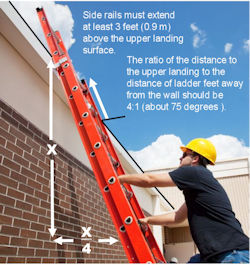Ladder Hazards
Falls from portable ladders are the leading cause of occupational fatalities and injuries in construction. According to the Bureau of Labor and Statistics, about 20 percent of all fatalities due to falls are related to the use of ladders.
OSHA rules for ladders in construction are covered in OSHA 29 CFR 1926.1053 and in general industry, 29 CFR 1910.23.
In construction, ladders must be inspected by a competent person for visible defects on a periodic basis and after any occurrence that could affect their safe use.
Precautions
To protect employees from falls from ladders take the following recommended precautions:
- Use the 4:1 rule: Place the ladder's base a distance away from the wall or upper support equal to 1/4th the effective working length of the ladder. This practice will set the ladder at about a 75-degree angle.
- Avoid electrical hazards. Look for overhead power lines before handling a ladder. Avoid using a metal ladder near power lines or exposed energized electrical equipment.
- Always inspect the ladder prior to using it. If the ladder is damaged, it must be removed from service and tagged until repaired or discarded.
- Always maintain a 3 points of control (two hands and a foot, or two feet and a hand) on the ladder when climbing and always face the ladder while climbing.
- Only use ladders and appropriate accessories (ladder levelers, jacks or hooks) for their designed purposes.
- Ladders must be free of any slippery material on the rungs, steps or feet.
- Do not use a self-supporting ladder (e.g., step ladder) as a single ladder or in a partially closed position.
- Do not use the next-to-the-top or top step/rung of a ladder as a step/rung unless it was designed for that purpose.
- Use a ladder only on a stable and level surface, unless it has been secured (top or bottom) to prevent displacement.
- Do not place a ladder on boxes, barrels or other unstable bases to obtain additional height.
- Do not move or shift a ladder while a person or equipment is on the ladder.
- An extension or straight ladder must extend at least 3 feet above the point of upper support.
- A ladder placed in any location where it can be displaced by other work activities must be secured to prevent displacement or a barricade must be erected to keep traffic away from the ladder.
- Be sure that all locks on an extension ladder are properly engaged.
- Do not exceed the maximum load rating of the ladder.
- Be sure the load rating can support the weight of the user, including materials and tools.
- Do not use metal ladders near electrical work and overhead power lines.
For a complete course on ladder safety, take OSHAcademy Course 603 Stairway and Ladder Safety.
For more information on ladder safety see:
- OSHA's Falling Off Ladders Can Kill: Use Them Safely;
- Reducing Falls in Construction: Safe Use of Extension Ladders; and
- Reducing Falls in Construction: Safe Use of Stepladders.
Knowledge Check Choose the best answer for the question.
3-2. In construction, who must regularly inspect ladders for defects?
You forgot to answer the question!

